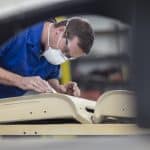When you invest in a vehicle, you want to ensure it lasts as long as possible, and this includes the tires. One important aspect that plays a significant role in the life of your tires is the alignment. Specifically, a front end alignment can have a major impact on the longevity of your tires. If you’ve ever experienced your car pulling to one side or your steering wheel shaking while driving, you’ve likely encountered an alignment issue. In this article, we’ll dive into the importance of front end alignment, how it can extend your tire’s life, and what signs to look out for that may indicate a need for a tire alignment.
Understanding the Importance of Front End Alignment
Before delving into how a front end alignment can extend the life of your tires, it’s crucial to understand what this service entails. When we talk about alignment, we’re referring to the adjustment of a vehicle’s suspension, which is essentially the system that connects your car to its wheels. A front end alignment specifically targets the front wheels, ensuring they’re correctly angled and positioned relative to the vehicle’s centerline.
Lire également : What Are the Best Tips for Keeping Your Car’s Electrical System in Top Shape?
When your vehicle’s alignment is off, it can result in uneven or rapid wear on your tires. This can be due to the tires not hitting the road at the correct angle or because the tires are unevenly distributing the weight of your car. A front end alignment helps avoid these issues by ensuring the tires are aligned correctly.
Recognizing the Signs of Misalignment
Recognizing the signs of misalignment is crucial. Not only can it save you money on tire replacements, but it can also improve your car’s performance and fuel efficiency. There are several signs that your vehicle may need a front end alignment, which include:
Sujet a lire : How to Choose the Right Power Inverter for Your Car?
- Uneven or rapid tire wear: This is often the most obvious sign of alignment issues. If you notice your tires wearing out unevenly or faster than usual, it could be due to misalignment.
- Vehicle pulling to one side: If your vehicle consistently pulls to one side while you’re driving, this could indicate an alignment issue.
- Steering wheel vibration: A vibrating steering wheel is another common sign of alignment problems. This typically results from the front tires pulling against each other in opposite directions.
By regularly checking for these signs, you can address any alignment issues early on and prevent unnecessary wear on your tires.
The Role of Front End Alignment in Tire Longevity
Proper wheel alignment is critical in prolonging the life of your tires. Misaligned wheels can cause your tires to wear unevenly and prematurely. When your tires are not aligned properly, they aren’t working together as efficiently as they could be. This can lead to increased friction and wear on the tires, which can rapidly decrease their lifespan.
When your wheels are correctly aligned, your tires wear evenly. This not only extends the lifespan of your tires, but it also improves the performance of your vehicle. You’ll likely notice a smoother ride and better gas mileage. Plus, it can also enhance the handling and safety of your vehicle, providing a more controlled and stable driving experience.
Maintaining Proper Wheel Alignment
Maintaining correct alignment is not a one-time task, but rather an ongoing part of vehicle upkeep. Many factors can knock your vehicle’s alignment off, from hitting a pothole to wear and tear on suspension components. Regular alignment checks should be a part of your car’s routine maintenance to ensure optimal performance and prevent unnecessary tire wear.
It’s recommended to get your alignment checked every two to three years. However, if you frequently drive on rough roads, carry heavy loads, or notice any signs of misalignment, you might need to have it checked more often.
In conclusion, proper front end alignment is essential in extending the life of your tires. It ensures optimal vehicle performance and a smoother, safer driving experience. By recognizing the signs of misalignment and maintaining proper alignment, you can protect your tires, optimize your vehicle’s performance, and ensure a safe drive on the road.
The Process of Front End Alignment
The process of front end alignment involves adjusting the angles of the front wheels so that they are parallel to each other and perpendicular to the ground. This helps ensure that your tires meet the road at the right angle and that they are centered in the wheel wells. A front end alignment is typically performed using a specialized machine that can precisely measure wheel angles and make the necessary adjustments.
Alignment specifications can vary based on the type of vehicle and its intended use. For instance, a sports car may require a different alignment than a pickup truck. The alignment process takes into account factors such as caster (the angle of the steering pivot), camber (the angle of the wheel in relation to the road), and toe (the direction the tires are pointed).
Misalignment can occur for various reasons, including a minor accident, hitting a pothole, or general wear and tear. Whatever the cause, it’s important to get your vehicle’s alignment checked when you suspect a problem. Neglecting a misalignment can lead to more serious issues down the line, such as tire damage, decreased fuel efficiency, and even mechanical problems.
Cost and Time Considerations for Front End Alignment
Typically, a front end alignment is neither time-consuming nor expensive. Most mechanics can complete the process in less than an hour. The cost can vary based on where you live and the specific make and model of your vehicle, but on average, you can expect to pay between $50 and $100.
Given the relatively low cost and quick turnaround time, front end alignments are a wise investment to maintain your vehicle’s performance and extend the life of your tires. Considering that a set of new tires can cost several hundred dollars, regular alignments can save you money in the long run.
Conclusion
In conclusion, ensuring that your vehicle has a proper front end alignment is a crucial aspect of vehicle maintenance. Not only does it extend the life of your tires, but it also enhances your car’s performance and safety. Remember, a misaligned vehicle can lead to uneven tire wear, decreased fuel efficiency, poor handling, and even potential mechanical issues. So, recognizing the signs of misalignment and having regular alignment checks can save you from unnecessary expenses and help provide a smoother, safer driving experience. As with all aspects of vehicle maintenance, an ounce of prevention is worth a pound of cure.






